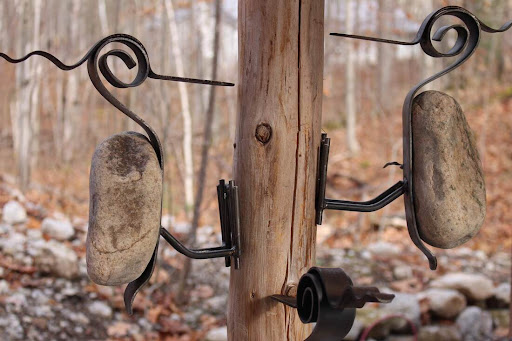Creating metal art can be a rewarding and fulfilling hobby, but it’s crucial to prioritize safety from the start. Whether you’re crafting metal garden art or intricate sculptures, following safety tips for DIY metal art is essential to protect yourself and ensure a successful project. This article will guide you through essential safety measures, offering valuable insights for beginners and seasoned artists alike.

Understanding the Basics of Metal Art
Before diving into the world of DIY metal art, it’s important to understand the materials and tools you’ll be working with. Metals like steel, aluminum, and copper are popular choices, each requiring specific techniques and precautions. Familiarize yourself with the properties of these metals and the tools needed for cutting, welding, and shaping them.
Choosing the Right Metal for Your Project
Selecting the appropriate metal is crucial for both the success and safety of your project. Consider factors such as durability, weight, and corrosion resistance. For outdoor projects, refer to resources like metal garden art to explore suitable options.
Essential Tools for Metalworking
Investing in quality tools is essential for achieving precision and maintaining safety. Common tools include welders, grinders, and metal shears. Ensure all tools are in good condition and suitable for the metal type you’re working with.
Personal Protective Equipment (PPE)
Personal protective equipment is a non-negotiable aspect of DIY metal art. Wearing the right gear can prevent injuries and long-term health issues.
Protective Clothing
Wear flame-resistant clothing, gloves, and safety boots to shield your skin from sparks, heat, and sharp metal edges. Long sleeves and pants are recommended to cover exposed skin.
Eye and Ear Protection
Safety goggles or a welding helmet with a protective shield are essential to prevent eye injuries from flying debris and intense light. Additionally, use ear protection to safeguard against the loud noises generated by metalworking tools.
Workshop Safety
A well-organized and clean workshop is vital for maintaining safety. Proper ventilation, lighting, and storage of materials and tools contribute to a safer working environment.
Ventilation
Ensure your workspace is well-ventilated to prevent the accumulation of fumes and dust. If necessary, install exhaust fans or open windows to maintain air circulation.
Lighting
Adequate lighting is crucial for precision and safety. Ensure your workspace is well-lit to minimize the risk of accidents and enhance the quality of your work.
Proper Tool Handling
Understanding how to operate and maintain your tools is essential for safety and efficiency. Follow manufacturer instructions and seek training if necessary.
Safe Tool Operation
Always operate tools according to the manufacturer’s guidelines. Pay attention to safety features and never bypass safety mechanisms.
Tool Maintenance
Regularly inspect and maintain tools to ensure they are in good working condition. Replace damaged or worn-out tools promptly to prevent accidents.
Fire Safety Measures
Working with metal involves high temperatures and sparks, increasing the risk of fire. Implement fire safety measures to protect yourself and your workspace.
Fire Extinguishers
Keep a fire extinguisher within reach and ensure you know how to use it. Familiarize yourself with the different types of extinguishers and select the appropriate one for your workshop.
Safe Storage of Flammable Materials
Store flammable materials away from your workspace and heat sources. Use appropriate containers and follow safety guidelines for storage.
First Aid Preparedness
Despite taking precautions, accidents can happen. Being prepared with a first aid kit and knowing basic first aid procedures is essential.
First Aid Kit Essentials
Stock your first aid kit with items such as bandages, antiseptics, and burn ointments. Regularly check the kit to ensure supplies are up-to-date and replenished.
Basic First Aid Skills
Learn basic first aid skills, including how to treat cuts, burns, and eye injuries. Consider taking a first aid course to enhance your knowledge and preparedness.
Post-Project Safety
Once your project is complete, ensure your workspace is clean and safe for future use.
Cleaning up Your Workspace
Remove debris, store tools properly, and dispose of waste materials according to safety guidelines. A tidy workspace reduces the risk of accidents in future projects.
Inspecting Your Finished Art
Inspect your finished art for sharp edges or loose parts that could pose a hazard. Make necessary adjustments to ensure both safety and aesthetic quality.
Continuous Learning and Improvement
Stay informed about new techniques and safety practices by participating in workshops and engaging with the metal art community.
Joining Metal Art Forums
Joining forums and online communities allows you to exchange knowledge and learn from experienced artists. Consider visiting abstract metal garden art for inspiration and tips.
Attending Workshops and Classes
Participate in workshops and classes to enhance your skills and stay updated on the latest safety practices. Networking with fellow artists can also provide valuable insights and encouragement.
Conclusion
Pursuing DIY metal art is an exciting and creative endeavor that requires careful attention to safety. By following these safety tips for DIY metal art, you can enjoy the art-making process while minimizing risks. Remember to prioritize personal protective equipment, maintain a safe workspace, and continuously improve your skills. For more ideas and guidance, explore stainless steel garden art and other resources to fuel your creative journey.

Frequently Asked Questions
What is the most important safety tip for DIY metal art?
Wearing appropriate personal protective equipment, including gloves, goggles, and flame-resistant clothing, is the most crucial safety tip for any metal art project.
How can I ensure my workspace is safe for metalworking?
Ensure proper ventilation, adequate lighting, and organized storage of tools and materials to create a safe and efficient workspace.
Why is it essential to join metal art communities?
Joining metal art communities allows you to exchange knowledge, learn new techniques, and stay informed about the latest safety practices in the field.
This article contains affiliate links. We may earn a commission at no extra cost to you.

